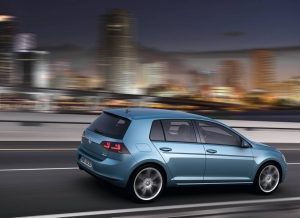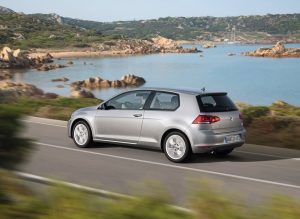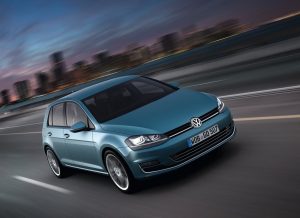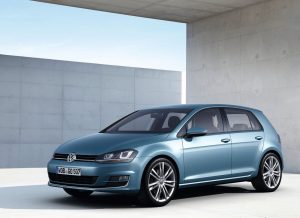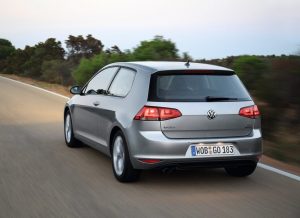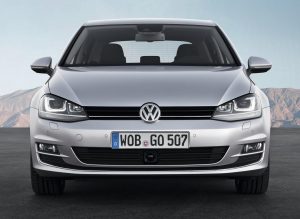Rate this article
Volkswagen Golf is a product of Volkswagen, located in Germany. The popular hatchback became the company's most successful car and took 3rd place among the best-selling vehicles. According to information for 2007, more than 25,000,000 copies were produced. Auto is the flagship of purchases among European motorists.
The machine serves as the founder of the golf class. Interestingly, it was recognized as the “Japanese Import Car of the Year” (2004-2005). At the beginning of 2013, the car of the 7th family was named the best car of the year at the World Car of the Year competition, held every year. The entire Volkswagen lineup.
Car history
1st generation – A1 (1974-1993)
The famous vehicle made its public debut in 1974. Volkswagen Golf 1 received a special name in honor of the warm ocean current - the Gulf Stream. Modest plastic trim, angular design solutions and average comfort were justified by a front-wheel drive layout (which was extremely rare at that time), a rich range of engines running on diesel fuel and gasoline, a choice of bodies (3- or 5-door hatchback, Jetta sedan and cabriolet).
The first generation had a rear window washer, a wiper, a sliding sunroof, a lockable gas tank cap and alloy wheel rims. In the United States of America and Canada, the vehicle was produced under the name VW Rabbit. The design of the Volkswagen Golf 1 was developed by the Italian automobile designer Giorgetto Giugiaro.
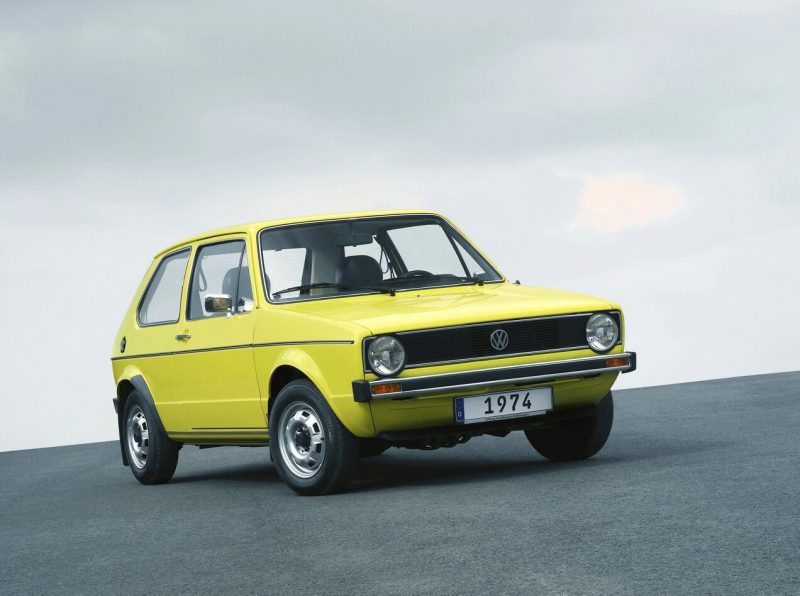 Volkswagen Golf first generation
Volkswagen Golf first generation The standard engine was a 1.1-liter power plant producing 50 horsepower. A little later, they began to install a diesel variation of a 50-horsepower 1.5-liter engine. Such engines made it possible to accelerate to 90 km/h in 13.2 seconds, and the top speed was 149 kilometers per hour.
Average fuel consumption was 8.6 liters per 100 kilometers. The most powerful was the Golf GTI, which had a power unit with a volume of 1.6 liters, a K-Jetronic fuel injection system and an output of 110 horsepower. With such an engine, the car accelerated to 183 km/h, and it took only 9 seconds to overcome the first hundred kilometers per hour.
The sports version of the model had the price tag of a small car and the dynamism of a sports coupe. The GTI featured dark window surrounds, sporty-style seats and steering wheel, and wider plastic wheel frame trims.
Initially, those who bought a Golf were offered a car not only with a mechanically switched transmission, but also with an automatic transmission. Already from the first generation, the German car had fairly good equipment, which made it possible to feel comfortable while sitting behind the wheel of a hatchback.
By 1979, the company introduced a new Golf convertible, which had a folding soft top. The bodywork was carried out by the well-known Karmann studio in the city of Osnabrück. They decided to create convertible cars before the design of the 3rd generation Golf. Partly, this happened due to the fact that the convertible of the 2nd family could not be released.
A little later, the model grid was replenished with a convertible and a sedan, which received its name Jetta. The production of hatchbacks was completed in 1983, convertibles were still produced until 1993. In the Republic of South Africa, cars in an improved form under the name Citi were made until 2009. In total, the Golf 1 family was produced in a circulation of 6,700,000 vehicles.
Despite the fact that the GTI version of the first generation Golf was released in 1976, the international magazine Sports Car International awarded it third place among the best cars of the eighties.
2nd generation – A2 (1983-1992)
When 1983 came, Golf 1 was replaced by the 2nd family. The new product came out more voluminous, acquired modern equipment, which included ABS, power steering and an on-board computer. The Volkswagen Golf 2 has grown by 300 mm in length and by 55 mm in width, so the interior feels spacious and comfortable.
With the help of a modernized body shape, it was possible to reduce the air resistance indicator from 0.42 to 0.34. The experts decided to keep the most recognizable design elements, but they were supplemented and improved.
Three years later (in 1986), the all-wheel drive Syncro version was released. The “charged” version of the Volkswagen Golf G60 had a 1.8-liter power plant under the hood, which developed 160 horsepower. There was mechanical supercharging.
The second family was more generous with modifications. By 1984, many saw the auto GTI, which had 8-valve engines that developed 112 “horses”. From the beginning of 1990-1991, they produced an “off-road” model of the Volkswagen Golf Country, developed together with the company Steyr-Daimler-Purch. The Country differed from the standard version of the car with all-wheel drive by an increased ground clearance of 63 millimeters and related elements.
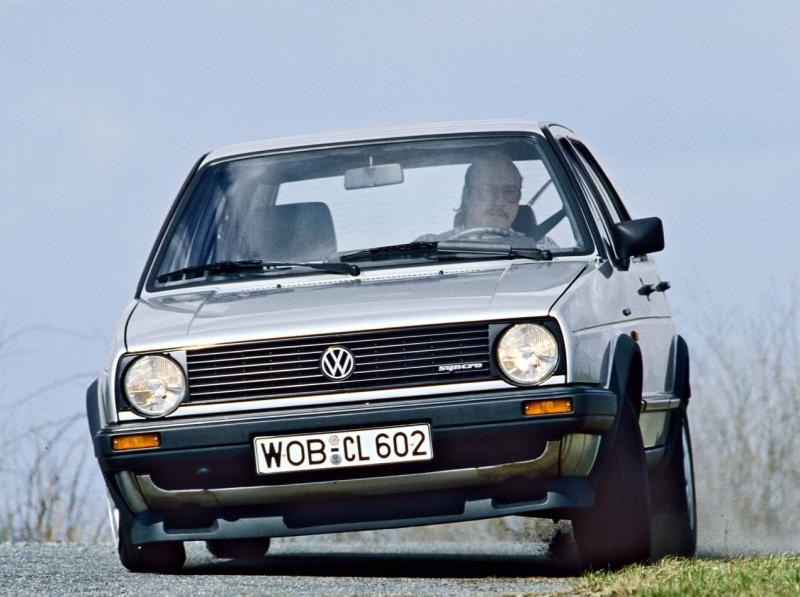 Golf Syncro
Golf Syncro The body, along with the Golf Syncro installations, was placed on the frame, with the help of which the car received increased ground clearance. In addition, there is a viscous coupling in the rear axle drive, which automatically connects the rear wheels when the front ones slip.
However, the demand for such a version turned out to be lower than planned - only 7,735 vehicles were produced. They produced 2 families of cars until 1992; in total, 6,300,000 units were built.
3rd generation – A3 (1991-2002)
The third Golf family took its first steps in August 1991 at the Geneva Motor Show. The body was produced as a three-door and five-door hatchback, a Golf Variant station wagon version, as well as a convertible. With the back of the rear sofa folded down, the trunk of the station wagon acquired a volume of 1,425 liters.
The third generation acquired a special design solution, and there was more free space inside. There was an abundance of auxiliary equipment, for example, ABS, electric seat heating, air conditioning, electric drive for adjusting the angle of the seat backs.
They did not forget to install centralized control of locks, electrical adjustment of the position of external mirrors, options for advance heating of the power unit in winter, etc.
 Volkswagen Golf third generation
Volkswagen Golf third generation The arsenal of power plants had 7 engines running on gasoline (from 1.4 liters with a capacity of 60 horsepower, to the high-spirited VR6 12V, 190 horsepower, with a volume of 2.9 liters). There were engines running on diesel fuel (a pair of naturally aspirated engines, 64/75 horsepower, respectively, and a single turbo engine that produced 90 horsepower).
All gasoline engines had neutralizers. The weakest power unit has a volume of 1.4 liters, and the most powerful – 2.8 liters. The latter accelerated the car to 225 km/h, and the first “hundred” took 7.6 seconds. The most powerful options came with a four-speed automatic transmission with an electric hydraulic drive.
The box had two programs - economy and sport style of movement. All wheels received disc brakes, and the front ones were ventilated. Servo power steering and brake systems began to be installed on all models.
 Volkswagen Golf engine
Volkswagen Golf engine By 1995, the original Golf appeared, equipped with a 2.8-liter VR6. The idea of the new engine was as follows: they took a standard V-shaped six-cylinder engine and changed the angle between the two cylinders by 15 degrees so that all the pistons fit under one cylinder head.
This allowed the engine to develop 172 horsepower. The sedan version was called Vento. The development department paid particular attention to the issue of security. The presence of easily crushed volumes during a collision, reinforced frames, and amplifiers integrated into the doors was used.
In addition, the 3rd generation hatchback had an Airbag for the driver and front passenger, a steering column deformable by 170 millimeters, a foam-covered dashboard and rear seat backs made of steel.
The German company did not forget to provide its customers with a guarantee against through corrosion for a period of 12 years. As a result, the third Golf sold 4,800,000 vehicles, and construction was completed in 1997.
4th generation – A4 (1997-2010)
Volkswagen Golf 4, produced in 1997, became longer, more solid and more comfortable. The interior now had similar styling to the Passat, and offered a considerable list of additional features. The range of choice of power plants has increased. The availability of turbodiesels, gasoline turbo engines, and gasoline units with a direct fuel injection system has appeared.
The list of engines has 6 petrol and 3 diesel variations, the power of which varies from 68 to 180 “horses”. The most powerful model is the Golf R32, which has a 3.2-liter 238-horsepower engine, an all-wheel drive system and a DSG preselective gearbox.
Without radical changes, the design team was able to make the hatchback more modern. Initially, non-standard lighting elements catch your eye. The combined glass cover hides a pair of massive low and high beam headlights, as well as a pair of small round direction indicators, along with fog lights.
The rear part of the car has noticeably changed, the most important part of which was now the rear roof pillar, which has a curved shape and flows into the wing. We decided to use sound-absorbing materials and new mounting elements for the engine and exhaust system. Volkswagen Golf 4 received 4 levels of equipment: Trendline, Comfortline, Highline and GTI.
I was very pleased with the list of basic equipment, which includes ABS, front Airbags for the driver and passenger, two side Airbags in the backs of the front seats, a four-wheel disc brake system (ventilated in front), power steering with variable ratio and steering force, adjustable according to the height of the driver's seat, the air dust filter of the ventilation system, headrests on the rear seats, bumpers and radiator grille painted to match the body color, as well as exterior rear-view mirrors.
If necessary, the center console can come with navigation installed on the LCD screen. There are elements that were previously absent in cars of this class. For example, in order for the windshield wipers to work intensively, they are monitored by a rain sensor. In Europe, the sedan version began to be called VW Bora. It was produced there until 2006, and in Brazil it is produced to this day.
Many car owners carry out minor tuning, especially for the 4th generation Volkswagen Golf. It is enough to equip the model with brand new wheels and a couple of aerodynamic body kits, and the car will become a real men's sports car.
It turns out that the Germans were right with the design of the model - it is truly universal. We can say that the fourth Golf is a kind of construction set that anyone can transform to suit their style and character.
5th generation – A5 (2003-2009)
The year 2003 came, which was marked by the appearance of the fifth generation of the car. The car was produced in a hatchback, station wagon, and also a sedan, which was called -. The hatchback was presented in the fall (September) at the Frankfurt Motor Show. They decided to build the vehicle on the newest base, which formed the basis of the Audi A3 of the 2nd family and the Volkswagen Touran.
It turns out that the hatchback has acquired a multi-link rear suspension, a brand new body, whose rigidity has been increased by 80 percent. Volkswagen Golf 5 has increased in length by 57 millimeters (4,204 mm), in width by 24 millimeters (1,759 mm) and in height by 39 millimeters (1,483 mm).
Passengers sitting behind were able to feel the increase in free space, as the legs became much freer (by 65 mm), and the ceiling height increased by 24 millimeters. In terms of dimensions, the new product is almost equal to the first version of the Passat, released in 1973. However, this is a consequence of modern changes - the car must be spacious, accommodate 5 people and several suitcases in the luggage compartment. The trunk has also increased in volume to 350 liters.
The exterior of the car has five main elements, where you can notice the belt line that runs under the side windows and rises up, the clear graphics of the side windows that form one single thing. The presence of raised-style sidewalls in the area of the aft pillars and doors, the inherent shape of the rear pillar, and the sweeping roof line, which is curved at an angle, clearly stands out.
It is easy to notice the completely fresh appearance of the design of the nose area, where there are improved aerodynamics. In place are twin round headlights with transversely mounted direction indicators, which, like the Phaeton, clearly “point” towards the central area of the “front end”.
Above the headlights rises the curved plane of the wings. Together with the hood and radiator grille, they draw a V-shaped style. The interior of the 5th generation is austere in standard German style, but it is functional and ergonomic. The functional departments are clearly separated, all the keys, along with the switches, are located in their usual places.
Every little thing, when compared with the previous version, has been refined and improved. For example, they decided to install the center console with the adjustments installed on it higher in order to increase their information content and make it easier to control. The design of the seats installed in front has been completely updated - now they provide maximum comfort.
The fifth Golf is the first vehicle in its category where you can optionally install seats with electrically adjustable lumbar support, which operates in 4 modes (built into the seat), or with an independent heater.
 Volkswagen Golf 5 interior
Volkswagen Golf 5 interior In addition, it is possible to install a front passenger seat with a forward-folding backrest. This allows you to extend the cargo area and transport cargo of increased dimensions. The fifth Golf received several variations of engines and transmissions.
The diesel line is represented by two engines: 2 liters with a capacity of 140 horsepower, and 1.9 liters with a capacity of 105 horsepower. The list of available gasoline engines is clearly larger: 1.6 liters, producing 102 horsepower, 1.4 liters, developing 75 “horses” and 1.6 liters, producing 115 horsepower. The Golf V is equipped with 1.4 TSI (there can be 3 units - 122, 140 and 170 horsepower) and 2.0 FSI (two options - 150/200 “horses”).
The fifth family comes with three versions of standard equipment: Trendline, Comfortline and Sportline, which differ in small finishing elements. Each of them has six airbags, ABS with Brake Assist and ESP.
At the end of 2004, they introduced the single-volume VW Golf Plus hatchback, which featured a different design solution. In total, by 2009, 3,300,000 cars were produced.
6th generation – A6 (2009-2012)
The 6th generation Volkswagen Golf debuted in October 2008 at the Paris Motor Show. The car was, in fact, a deeply modernized car from the previous family. Walter da Silva was responsible for the appearance of the car. The model was assembled in a three-door and five-door hatchback, as well as a station wagon and a convertible.
It so happened that the sixth generation came out when many countries began to introduce mandatory daytime running lights. The German company responded perfectly. All versions of the Golf had headlights with integrated daytime running lights. Due to the fact that the front part was updated, the “six” looked more dynamic than its predecessor.
The universal model began to stand out among its rivals. Despite the fact that the luggage compartment volume was slightly smaller than that of competitors, the Golf did not allow it to lose its position as a common family car. Even the first glance at the VW Golf 6 allows us to confidently conclude that the new product has become more elegant.
The optics installed in front, familiar to many from the Sirocco concept, are now radically different. The headlights are oval on one side and end in a sharp angle on the other. The optics installed at the rear did not disappoint – the contours of the headlights were drawn uniquely and elegantly.
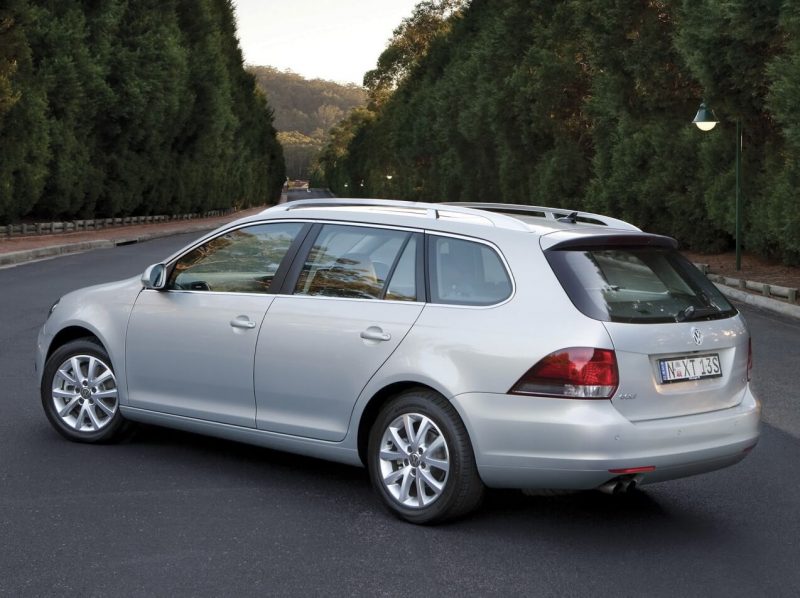 Volkswagen Golf station wagon
Volkswagen Golf station wagon They look a bit like an SUV. Despite the fact that the body panels (besides the roof) were made from scratch, the 6th family did not turn out to be supernova. It's still easy to treat him like an old friend.
The bumper has a friendly smile drawn on it; relief edges were drawn along the sides. The already wide rear pillar was made even wider. The window sill line dropped slightly, but the doors themselves, along with the doorways, did not undergo changes.
I was very pleased with the soundproofing. It’s not for nothing that the sixth generation is called the quietest in its segment. It was also possible to significantly improve handling, despite its already high level in the previous generation.
There aren't many changes inside either. The top of the dashboard looks new, along with the door panels and center console. The instrument panel, three-spoke steering wheel, control unit for the climate system and audio system - these elements were migrated from the VW Passat CC.
If earlier there was an inconvenient blue backlight for many, now it is gone. Instead, they introduced white-lunar backlighting, which looks more elegant and does not negatively affect the eyes. In general, the interior pleased with high quality materials: dark top, light bottom, beautifully crafted leather, literally everything reeks of solidity and quality.
It feels like you're in a higher class car. Of course, the basic equipment does not look so solid: the steering wheel does not have a leather braid and keys, the audio radio is simple, mechanical windows are installed on the rear doors, and the seats are not of such a relief type, they are upholstered in gray or black fabric. Although, as we said above, the luggage compartment has changed a little, it is nice that 4 convenient hook mounts are in place, and there is also a 12 V socket.
If we talk about power plants, there is a wide choice here. There are 7 petrol and 3 diesel engines. Gasoline engines include a 1.4-liter 16-valve 80-horsepower (since 2008), 1.6-liter 8-valve 102-horsepower (since 2008), 1.2-liter TSI producing 86 and 106 horsepower (since 2010 .), 1.4-liter TSI, developing 122 and 160 horsepower (since 2008).
 Gas engine
Gas engine Next come the TSI versions with a similar volume of 2.0 liters. The “weakest” sports model develops 211 horsepower and has been produced since 2009, followed by a 235-horsepower engine, which has been produced in limited edition for the Golf GTI “Edition 35” since 2011, and the last of the list is a gasoline engine producing 271 horsepower (produced since autumn 2009 for Golf R 2.0).
Diesel engines include the 1.6-liter TDI, which produces 90 and 105 “horses” (since 2009). There are also 2.0 liter TDI versions developing 110 and 140 horsepower (since 2008). The most powerful two-liter diesel engine has 170 horsepower - it has been produced since 2009.
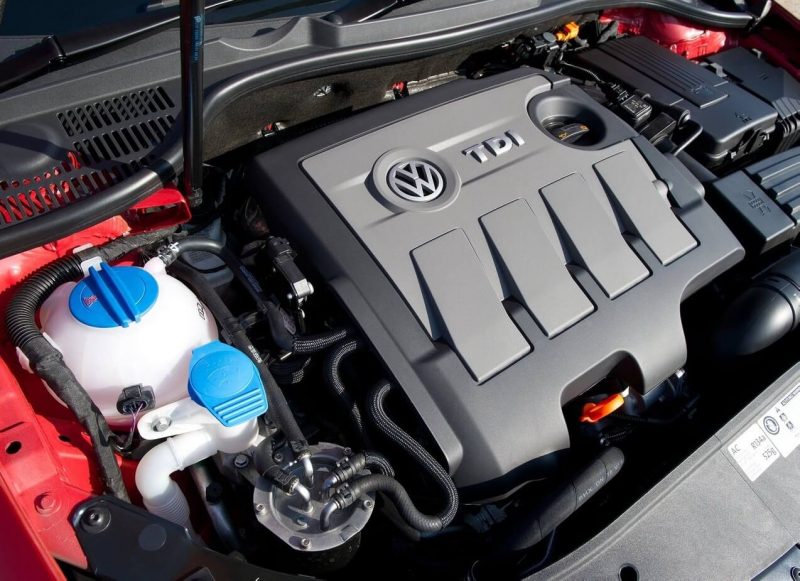 Diesel engine
Diesel engine The car's arsenal has several triumphant things. This includes the proprietary 4MOTION all-wheel drive system. None of the competitors in the segment have anything like it. However, this is not an innovation, because the company has equipped the model with a permanent all-wheel drive system since the 2nd family.
The sixth version uses the 4th generation Haldex electro-hydraulic multi-plate clutch. The cars were equipped with a 5- or 6-speed manual gearbox. A considerable number of Golfs have an automatic transmission with a DSG double clutch. Of course, the 6-speed DSG version with wet clutches is much more reliable than the 7-speed gearbox.
After the release of the 6th generation, as many as 4 suspension options were available. In addition to the standard one, it was planned to install reinforced (for heavy loads), sports and adaptive ACC, which had shock absorbers of variable stiffness.
The adaptive version has three firmness modes: comfortable, standard and sport. The suspension installed in front is also different. If earlier there were steel levers, transferred from the 5th family, then later they were replaced with aluminum ones. Which option is installed depends on the power unit.
7th generation – A7
Volkswagen Golf 7 was shown for the first time at the 2012 automobile show in Paris. They started selling cars right after the presentation. It is very pleasant that, despite the newest family of the car, its cost has remained at the same level. The new family received a wide range of changes, which had a positive effect on the percentage of sales.
Of course, the seventh variation cannot be called the best car in the segment, and the interior does not have an abundance of space, and the suspension is a little hard, but the highlight of this car is the “consistency” of all elements and the lack of decisive punctures.
Exterior
It was November 2016, German experts presented a modernized version of their own bestseller - Golf 7. The model received fundamental changes to the exterior - improved bumpers and lighting equipment, changes in the interior, upgraded power units and a brand new DSG gearbox.
They didn’t forget to install a set of electronic services, which are usually classified as more status machines. Although the seventh generation does not aim to win the title of “work of art”, its advantage is the presence of a balanced design and precise proportions. Considering this, we cannot say that the car is boring.

The front part has a rather aggressive appearance, which captures the “gloomy” gaze of the headlights (optional, full LED headlights can be installed), a narrow stripe of the radiator grille and a “curly” bumper. Looking at the hatchback from different angles, it’s hard to blame the designers.
The bumper, in principle, is of a simple type, has rectangular fog lights. The side part has embossed sidewalls with a laconic, but very stylish stamping, a clearly distinguished silhouette of the wheel arches, stylish LED lights and a neatly “sculpted” rear bumper.
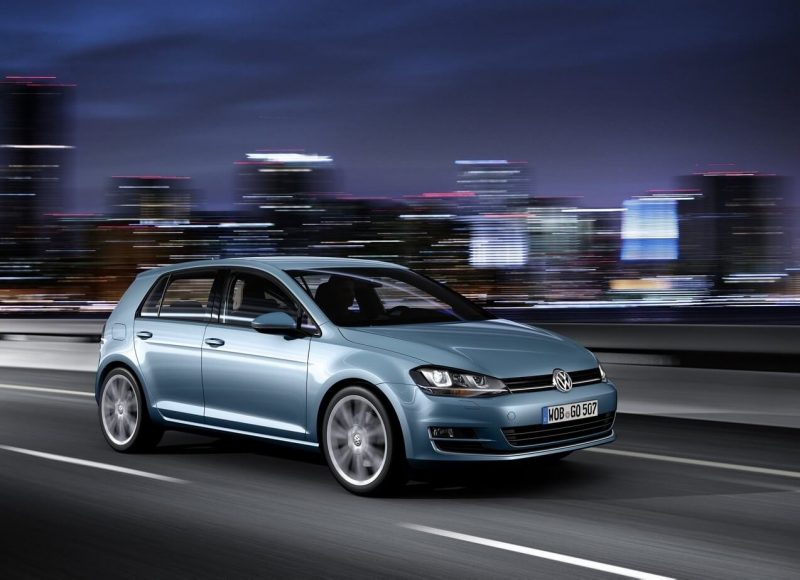


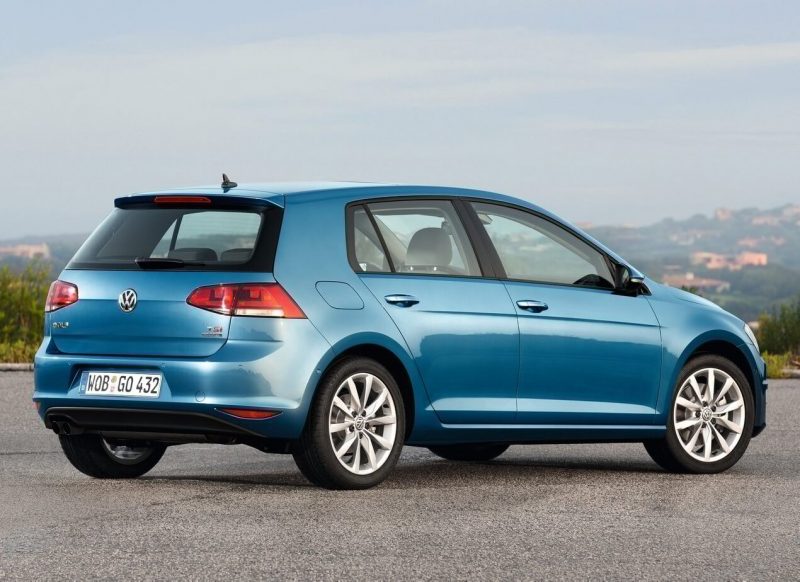
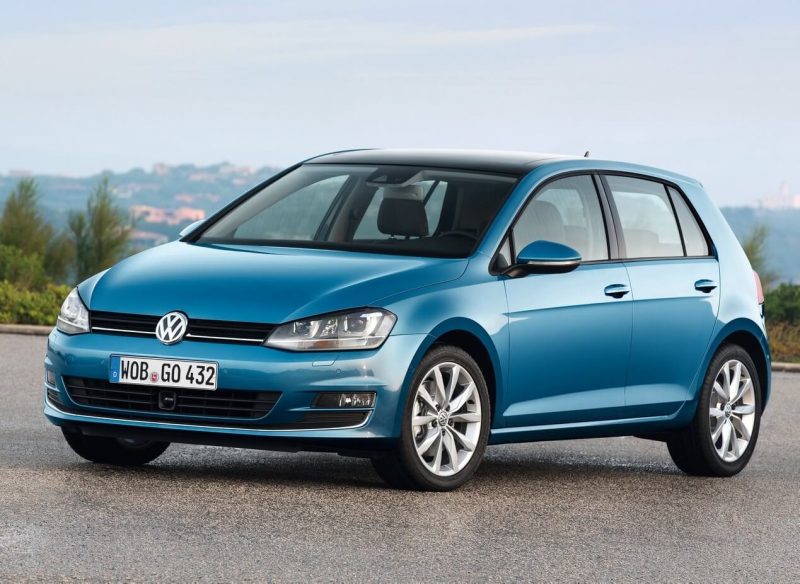
The designers introduced a stylish stamping line located under the door handles. The rear-view mirrors are supposedly installed on a leg, but in reality it is something between a pillar and a leg. The rear has a beautiful exterior design.
Some people complain that the taillights don't look as aggressive as the front ones. On the roof we see a spoiler that houses a brake light repeater. The rear bumper turned out to be quite massive - it has interesting shapes and reflectors.
A plastic protection was installed at the bottom of the bumper, and below it there are exhaust pipes. The seventh generation of Golf comes with two options - a 3-door or 5-door hatchback. Ground clearance – 160 millimeters.
Interior
Inside the “seventh” VW Golf there are some strict German elements, however, taking all this into account, the interior looks attractive and modern. Speaking about the quality of workmanship, the hatchback can “teach” many cars of a higher class, because all the finishing materials, along with the assembly, are at the highest level.
The center console, facing the driver, gracefully houses a color display of the infotainment system (the diagonal can be from 6.5 to 9 inches), as well as a very simple and functional climate control unit.
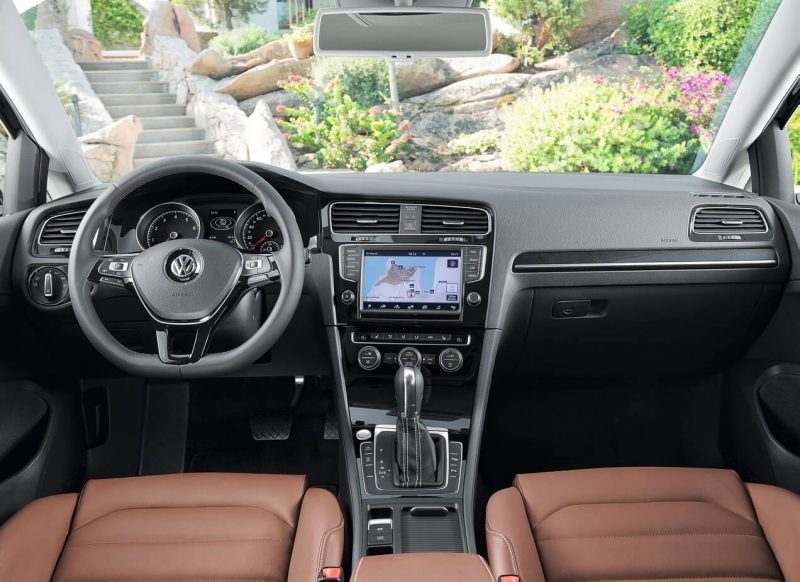 Golf 7 interior
Golf 7 interior The multifunctional steering wheel is conveniently located, cut off at the bottom for a sporty style. The steering column can be adjusted in height and reach. The presence of an informative dashboard is pleasing to the eye, where there are a couple of large circles in which additional instruments are placed.
The top version of the machine has a 12.3-inch color screen, placed instead of an analog instrument panel. The lowest part of the center console was given to a niche for small items.
At the time of its release, the seventh generation Golf received the title of “Car of the Year” and the corresponding WCOTY award.
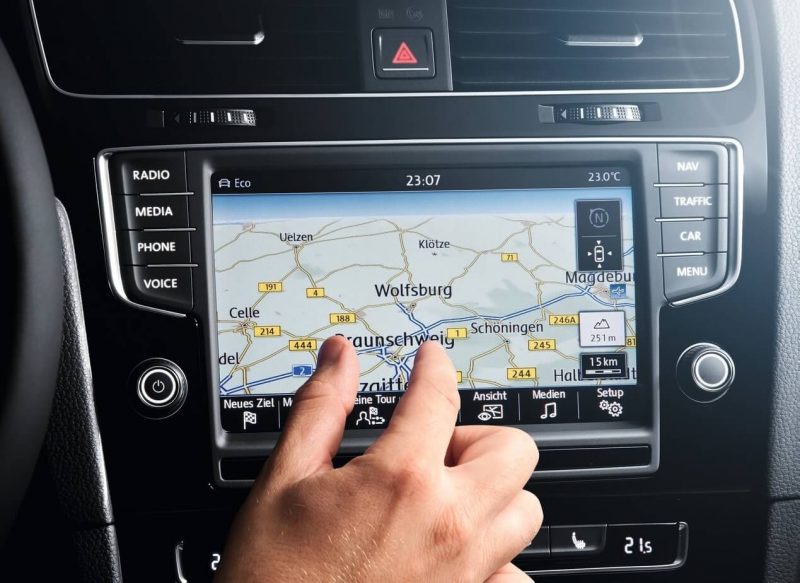 Multifunctional color screen
Multifunctional color screen The tunnel has a large transmission selector, around which there are buttons responsible for various options. You can set the hatchback to the parking brake by pressing a button. To the right of it, a niche with cup holders was installed. The organization of the interior space of the Golf 7 is excellent.
The front seats of the car have dense, optimal padding, a well-thought-out profile with prominent side support bolsters, as well as various ranges of settings.
 Rear sofa
Rear sofa The rear sofa was assembled with high quality, and there is enough free space in all directions. 3 passengers will be able to sit, but the person sitting in the middle will not be so comfortable, since there is a small tunnel under their feet. Despite the number of doors, the intelligently assembled luggage compartment of the seventh generation offers 380 liters of usable space.
If necessary, you can fold the back rows in a 40/60 ratio, then the volume will increase to 1,270 liters. A full-size spare tire and tools were hidden under the car's raised floor.
Specifications
Power unit
A similar hatchback, despite its generation, has always had a huge range of engines, so the 7th family is no exception. However, sadly, only 3 installations from a rich range of different motors arrived in the Russian Federation. The reasons are unknown. It wouldn’t be superfluous to mention that such engines are now being installed on brand new ones.
The “simplest” engine is naturally aspirated, has a volume of 1.6 liters and an injection distribution function. A DOHC gas distribution mechanism and 16 valves are installed. As a result, it develops 110 horsepower. This is enough to reach 100 km/h in 10 seconds.
 Engine with a volume of 1.6 liters
Engine with a volume of 1.6 liters The power unit consumes about 8 liters in city mode, and 5 liters on a straight road. Some do not recommend purchasing such a motor, but it has its main advantage - reliability due to its rather simple design. Next comes a turbocharged 1.4-liter 125-horsepower engine, which accelerates the compact hatchback to the first hundred in 9 seconds. “Maximum speed” is set at 204 kilometers per hour.
Today, many companies use turbocharging to save fuel during quiet driving - it turns out that in city mode the engine consumes less than 7 liters of 95 gasoline, and outside the city this figure drops to 4.3 liters. If we talk about efficiency, then the 1.4-liter engine is for you.
 TSI engine
TSI engine The line is completed by a similar 1.4-liter power unit, already producing 150 “horses”. This TSI engine has a lightweight winged metal block, direct feed and adjustable valve timing.
Torque was also increased by 50 values (250 Nm), which made it possible to reduce acceleration to 8.2 seconds. The maximum speed is 204-216 km/h. This unit consumes no more than 5 liters in a combined cycle.
Transmission
The 1.6-liter power unit is synchronized with a five-speed manual transmission or a 6-speed automatic transmission. The 125-horsepower unit can be equipped with a six-speed manual transmission or a 7-speed DSG robotic gearbox with a pair of clutches. The most powerful version comes only with a seven-speed DSG robotic gearbox, also with two clutches.
Suspension
The seventh generation of Golf was built on the modular MQB base, which has a monocoque body, the base of which is 80 percent made of high-strength steel. The front axle has an independent McPherson-type suspension, and the rear suspension has several options. If there is a weaker engine, then a semi-independent beam is installed; when the engine is stronger, a multi-link system is installed.
Steering
The Volkswagen Golf 7 has a rack-and-pinion steering mechanism, as well as an electromechanical power steering with progressive efficiency.
Brake system
Disc brakes are installed on all wheels, where the front brakes are ventilated. The braking system operates together with ABS, EBD, Brake Assist, etc. services.
Safety
Judging by the statements of the manufacturers, the safety level 7 of the Golf family is the highest. These are not empty words - Euro NCAP tests carried out in 2012 showed that the latest version of the car deserves 5 stars. The car received 9 airbags, a rear collision avoidance system, as well as the ability of the car to automatically close the sunroof and windows.
The safety of adults has the following rating - 94%, the safety of children - also 94%, the safety of pedestrians - 65%, auxiliary systems - 71%. IIHS safety. The frontal test with a small overlap area (25%) was rated good. The partial overlap frontal test (40%) was rated good.
The side crash test was also rated Good. The strength of the roof was rated as good. Head restraint safety was rated good. And this is the best estimate possible. There are 4 of them: good (G), acceptable (A), weak (M) and bad (P)
Crash test
Options and prices
There are 3 trim levels in total: Comfortline, R-Line and Highline. The cheapest car is priced at RUB 1,101,100. Basic equipment received:
- Fabric covering;
- ABS, ESP;
- Eight airbags;
- Multi-steering wheel;
- Weak audio system with CD;
- Dual-zone climate control;
- Help starting uphill;
- Wheel pressure sensor;
- Refrigerated box;
- Cruise control;
- Full electric package;
- Optics washers;
- Start/Stop systems;
The most expensive package is priced at RUB 1,298,160. Among other things, the car has xenon optics, anti-fog optics and a combined skin. As a separate option there is the presence of:
- Leather trim;
- Blind spot monitoring;
- Luke;
- Navigation system;
- Rain and light sensors;
- Rear view cameras;
- Driver fatigue sensors;
- Keyless entry;
- Start from a button;
- Automatic parking systems;
- Two parking sensors;
- Adaptive cruise control;
- Pre-heater.
| Equipment | Price | Engine | Box | Drive unit |
| 1.4 TSI MT6 Comfortline | 1 101 100 | gasoline 1.4 (122 hp) | mechanics (6) | front |
| 1.6 MPI AT6 Comfortline | 1 157 100 | gasoline 1.6 (110 hp) | automatic (6) | front |
| 1.4 TSI DSG Comfortline | 1 191 100 | gasoline 1.4 (122 hp) | robot (7) | front |
| 1.6 MPI AT6 Highline | 1 225 160 | gasoline 1.6 (110 hp) | automatic (6) | front |
| 1.4 TSI DSG Highline | 1 259 160 | gasoline 1.4 (122 hp) | robot (7) | front |
| 1.4 TSI 140 hp DSG Highline | 1 298 160 | gasoline 1.4 (140 hp) | robot (7) | front |
Prices are current as of February 2018.
Appearance
The new product will be available for purchase in 2017. It is clearly visible from the photographs that the car has grown in wheelbase. The car has a classic style. Thanks to the increased wheelbase, it was possible to create a better layout of free space inside the car. In addition to the extended wheelbase, the updated model began to look “sharper”.
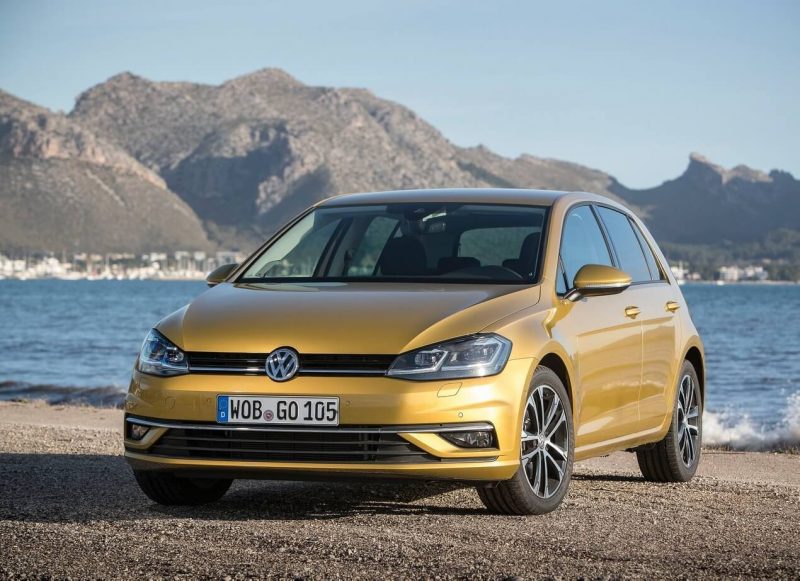 New Golf 2018
New Golf 2018 The body lines, which are sufficient, now look sharper, especially when compared with the 7th generation. The light-amplifying technology is also not similar to the usual one. Generally speaking, thanks to such innovations, the model has become aggressive and is vying for the right to be in charge.
Salon
As mentioned above, with the help of the wheel base that was added in size, the engineering staff was able to add a little more interior details, which may not be noticed during a quick inspection. However, what catches your eye is the presence of a modernized multimedia complex.
In the area of the driver's seat, everything looks so perfect that there is no desire to leave the car. Using the software installed in the multimedia system, you can connect your smartphone to it, after which the information will be combined. An integrated display that supports touch input quickly provides access to maps of the navigation system, which indicate the locations of traffic jams that have formed at a given time in the city.
Today's latest generation of Golf is an arsenal of innovative technologies that can correctly save fuel, brake, park and start in independent mode, recognize pedestrians and implement other options.
Technical specifications
To create the 8th generation, we used an improved version of the MQB base, familiar to most drivers from cars such as Audi, Skoda, and so on. Many believe that the new model will be able to reach its maximum capabilities (200 horsepower or even 300).
The manufacturer provides for the availability of gasoline and diesel engine options. There are rumors that a hybrid “filling” may appear. Volkswagen Golf 8 will most likely appear by the end of 2017 and will cost 1-2 million rubles.
Advantages and disadvantages
Pros of the car
- With each generation the car became more stylish and enjoyable;
- Beautiful design;
- Small dimensions;
- There is a choice of power units and transmissions;
- New efficient light optics;
- Good aerodynamic performance;
- Excellent security;
- Even the basic equipment is rich;
- Good dynamics;
- Low fuel consumption;
- Quite good noise insulation;
- Stylish interior;
- All elements are made with high quality;
- Excellent ergonomics;
- Comfortable seats;
- There is enough free space, despite the fact that it is a hatchback;
- Top trims come with a color instrument panel instead of a manual option;
- The center console has a color touch screen that allows you to display the necessary information and a navigation map on the screen;
- Pleasant suspension operation;
- Quite reasonable pricing policy of the company;
- Rich story;
- There are versions with an all-wheel drive system;
- The rear backrests fold down;
- Multifunctional steering wheel.
Cons of the car
- Small luggage compartment;
- The rear passenger in the center will be disturbed by the floor tunnel;
- Only 3 engine options are available for the Russian market;
- Many useful features are available only for a fee.
Let's sum it up
The Volkswagen Golf has always been a beautiful and reliable car, regardless of generation. Since its first release, the model has successfully won the respect of many car enthusiasts around the world. With each subsequent generation, this rating only increases. The hatchback is very convenient to use in urban areas due to its small dimensions, agility and rather modest “appetite”.
In terms of external design, the car is in no way inferior to its direct competitors. And if we talk about the interior decoration, then in some aspects it is even superior. The entire interior is literally imbued with high-quality assembly, high ergonomics and thoughtful functionality.
The power units, although not the most powerful, allow you to confidently overtake and drive uphill. Just look at the all-wheel drive system, which is present on some modifications. It is important that the Germans pay a lot of attention to ensuring the proper level of safety (the 7th generation received 5 maximum stars in European crash tests).
